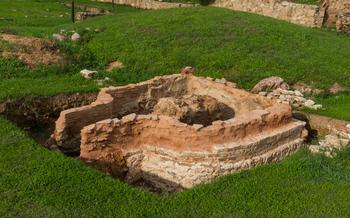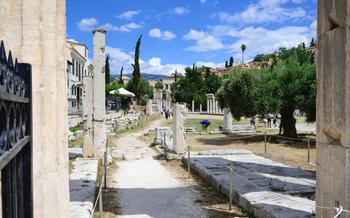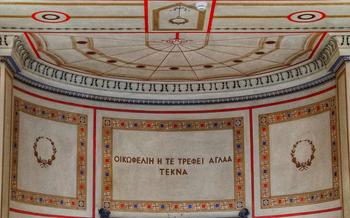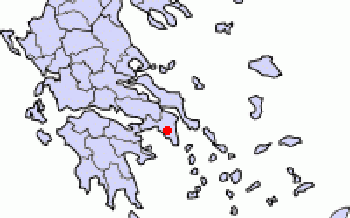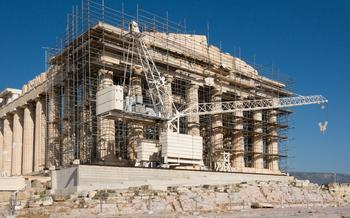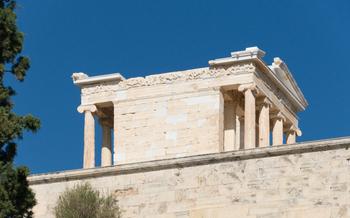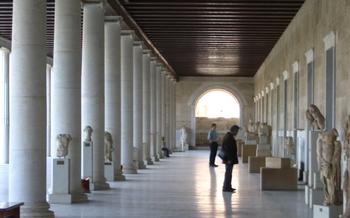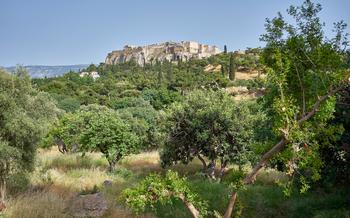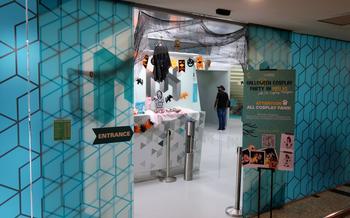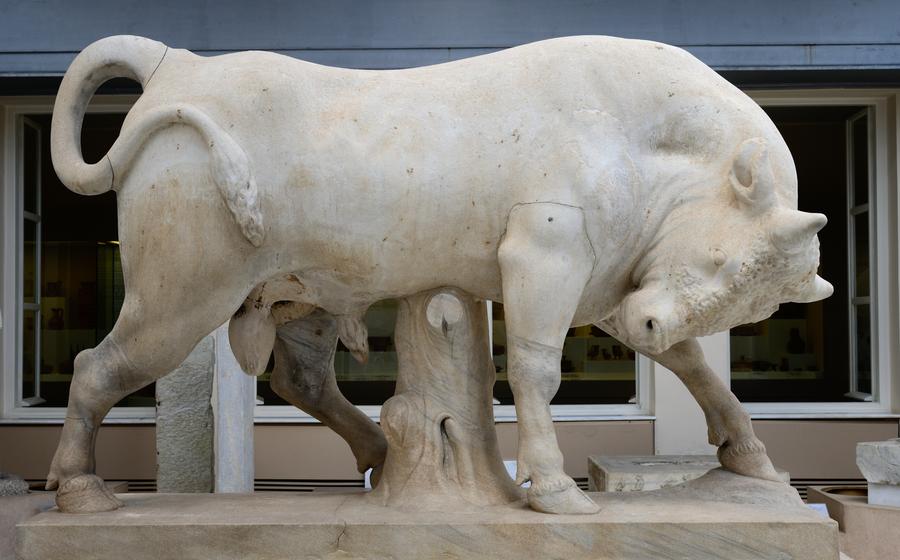
Kerameikos Archaeological Museum
- Historical Significance: A Journey Through Ancient Athenian Funerary Practices
- Location
- Hours of Operation and Admission
- Exploring the Museum: Unveiling Ancient Treasures
- Funerary Customs and Rituals
- Ancient Athenian Society
- Architectural Highlights
- Temporary Exhibitions and Events
- Photography and Videography
- Accessibility and Facilities
- Souvenirs and Gifts
- Educational Programs and Workshops
- Nearby Attractions: Exploring Athens' Ancient Neighborhoods
- Local Recommendations: Tantalizing Gastronomic Delights and Local Charms
- Insider Tip: Explore the Enchanting Neighborhoods
Historical Significance: A Journey Through Ancient Athenian Funerary Practices
The Kerameikos Archaeological Museum stands as a testament to the rich history and funerary practices of ancient Athens. Situated in the heart of the ancient Kerameikos cemetery, the museum offers a glimpse into the lives and beliefs of the Athenian people. The necropolis, dating back to the 11th century BC, served as a burial ground for prominent Athenian citizens, including statesmen, generals, and philosophers. Over the centuries, the cemetery evolved, reflecting the changing social and cultural landscape of Athens.
The museum's collection of funerary artifacts provides a fascinating insight into the rituals and customs surrounding death and the afterlife in ancient Athens. From elaborate grave stelae adorned with intricate reliefs to humble offerings placed with the deceased, these artifacts offer a glimpse into the lives and beliefs of the ancient Athenians. The museum's collection is not merely a display of ancient objects; it is a journey through the history of Athens, its people, and their relationship with death.
Location
The Kerameikos Archaeological Museum is situated at 148 Ermou Street, in the heart of Athens' historical center. It is conveniently located within walking distance from several major landmarks, including the Acropolis, the Ancient Agora, and the National Archaeological Museum. The museum's proximity to the Thissio metro station and numerous bus stops makes it easily accessible by public transportation.
For those arriving by car, limited street parking is available in the surrounding area. Alternatively, visitors can use the nearby parking lot at the Athens City Hall, just a short walk from the museum.
To reach the Kerameikos Archaeological Museum from various points in the city, visitors can follow these directions:
-
From the Acropolis: Take Dionysiou Areopagitou Street towards Thissio. Turn left onto Apostolou Pavlou Street and continue until you reach Ermou Street. The museum will be on your right.
-
From the Ancient Agora: Head northwest on Adrianou Street towards Thissio. Turn right onto Ermou Street, and the museum will be on your left.
-
From the National Archaeological Museum: Walk south on Patission Street towards Thissio. Turn left onto Ermou Street, and the museum will be on your left.
Hours of Operation and Admission
The Kerameikos Archaeological Museum is open to the public from Tuesday to Sunday. During the summer months (April 1st to October 31st), the museum's hours are from 8:00 AM to 8:00 PM. In the winter months (November 1st to March 31st), the museum is open from 8:00 AM to 3:00 PM.
Admission fees for adults are 6 euros, while students and children under 18 years old are admitted for free. Every first Sunday of the month, entrance is free for all visitors. The museum offers guided tours in English, French, German, and Spanish at an additional cost. Visitors are advised to book their tours in advance, especially during peak season.
Exploring the Museum: Unveiling Ancient Treasures
As you step inside the Kerameikos Archaeological Museum, prepare to be captivated by an array of artifacts that narrate the fascinating story of ancient Athenian culture. The museum's layout is designed to guide you through different sections, each offering a glimpse into the lives and customs of the people who once called Athens home.
Among the must-see exhibits is the Dipylon Vase, a colossal vessel that stands as a testament to the artistry and craftsmanship of ancient Greek potters. Its intricate decorations depict scenes of mourning and processions, providing insights into the funerary rituals of the time.
Another highlight of the museum is the collection of sculptures from the Sacred Gate. These exquisite works of art once adorned the entrance to the cemetery, welcoming visitors with their serene presence. The sculptures depict various mythological figures and scenes, offering a glimpse into the religious beliefs and artistic traditions of ancient Athens.
As you explore the museum's galleries, take time to ponder the significance of the artifacts on display. Each piece tells a story, revealing the beliefs, traditions, and daily lives of the people who lived in Athens centuries ago. From funerary stelae with poignant inscriptions to intricate jewelry and pottery, the museum's collection offers a window into the past that is both captivating and thought-provoking.
Funerary Customs and Rituals
The ancient Greeks held elaborate funerary customs and rituals that reflected their beliefs about the afterlife. Burials were typically conducted either through inhumation, where the deceased was laid to rest in a grave, or cremation, where the body was burned on a pyre. The choice of burial method often depended on the family's wealth and social status.
Grave goods and offerings played a significant role in ancient Greek funerary practices. These items, which could include pottery, jewelry, weapons, and other personal belongings, were placed in the grave to accompany the deceased into the afterlife. The belief was that these objects would provide comfort and sustenance to the departed in the next world.
One of the most striking aspects of ancient Greek funerary customs is the practice of erecting elaborate grave markers and monuments. These markers, which ranged from simple stelae to grand sculptural masterpieces, served to commemorate the deceased and honor their memory. They often featured inscriptions that recorded the individual's name, age, and accomplishments, as well as scenes from their life or mythology.
Ancient Athenian Society
The Kerameikos cemetery offers a unique glimpse into the social structure of ancient Athens. The elaborate grave markers and offerings found at the site reflect the importance of family and lineage in Athenian society. Wealthy and influential families often constructed elaborate tombs and monuments to honor their deceased relatives, while simpler graves were reserved for the less fortunate. The presence of both grand and modest burials at the Kerameikos cemetery highlights the diverse social classes that coexisted in ancient Athens.
One notable individual buried at the Kerameikos cemetery is the orator Demosthenes, who played a crucial role in Athenian politics during the 4th century BC. His tomb, which features a life-size statue of the orator, is a testament to his enduring legacy and influence. Other notable figures buried at the cemetery include the philosopher Epicurus, the playwright Menander, and the statesman Lycurgus.
The burial practices at the Kerameikos cemetery also shed light on the religious beliefs of the ancient Athenians. The presence of grave goods and offerings, such as pottery, jewelry, and food, suggests that the Athenians believed in an afterlife where the deceased would continue to need and use these items. The practice of cremation, which was common among the Athenians, was also believed to purify the soul and prepare it for the journey to the underworld.
Architectural Highlights
The Kerameikos Archaeological Museum, housed in a remarkable building designed by the renowned architect Ernst Ziller, stands as a testament to the harmonious blend of ancient ruins and modern architecture. Ziller's design seamlessly integrates the remnants of the ancient cemetery into the museum's contemporary structure, creating a unique and immersive experience for visitors.
The museum's exterior features a striking neoclassical facade, adorned with intricate details and sculptures that evoke the grandeur of ancient Greece. As you step inside, the spacious atrium welcomes you with its soaring ceilings and abundance of natural light, highlighting the impressive collection of funerary stelae and sculptures arranged throughout the space.
The museum's layout is designed to guide visitors through a chronological journey of ancient Athenian funerary customs. Each section or gallery features unique architectural elements that complement the artifacts on display. For instance, the Hall of the Dipylon Vases boasts a vaulted ceiling that mimics the shape of a tholos tomb, enhancing the impact of the exquisite vases exhibited within.
Throughout the museum, visitors can admire the intricate carvings and decorative motifs that adorn the ancient tombstones and sculptures. These artworks provide valuable insights into the artistic traditions and symbolism of ancient Athens. The careful restoration and preservation of these artifacts within the modern museum setting create a powerful connection between the past and the present.
One of the most striking features of the museum is the outdoor section, where visitors can explore the actual archaeological site of the ancient cemetery. Here, among the well-preserved ruins of tombs and funerary monuments, visitors can gain a deeper understanding of the burial practices and rituals of ancient Athens.
The Kerameikos Archaeological Museum's architecture serves as a reminder of the enduring legacy of ancient Greek culture. Ziller's skillful integration of ancient and modern elements creates a captivating environment that invites visitors to delve into the rich history and traditions of ancient Athens.
Temporary Exhibitions and Events
The Kerameikos Archaeological Museum hosts temporary exhibitions and special events throughout the year, showcasing new discoveries, collaborations with other institutions, or unique perspectives on ancient Athenian culture. These exhibitions offer visitors a chance to explore specific themes or topics in greater depth and experience the museum's collection in new and exciting ways.
The frequency and duration of these exhibitions vary depending on the nature of the display and the availability of artifacts. Some exhibitions may run for several months, while others may be shorter in duration. Visitors are encouraged to check the museum's website or social media pages for up-to-date information on current and upcoming exhibitions.
Recent exhibitions have explored topics such as the role of women in ancient Athens, the history of the Olympic Games, and the influence of ancient Greek art on modern culture. These exhibitions often feature rare or seldom-seen artifacts from the museum's collection, as well as loans from other institutions around the world.
Attending a temporary exhibition at the Kerameikos Archaeological Museum is a great way to enhance your understanding of ancient Athenian culture and gain new perspectives on the museum's collection. These exhibitions offer a unique opportunity to learn about the latest research and discoveries in the field of archaeology and to see firsthand how ancient artifacts are interpreted and presented in a modern context.
Photography and Videography
Photography and videography are generally permitted within the Kerameikos Archaeological Museum, allowing visitors to capture their experiences and share them with others. However, it's important to be mindful of certain restrictions and guidelines. Flash photography is prohibited in certain areas to protect the delicate artifacts from damage. Additionally, some exhibits or sections of the museum may have specific restrictions, which will be clearly marked.
Taking photos and videos is a great way to document your visit and create lasting memories. It allows you to capture the beauty of the artifacts, the atmosphere of the museum, and your own personal experiences. You can share these moments with friends and family, or use them to create a travel blog or social media post about your trip.
Tips for Taking Great Photos and Videos:
-
Use natural light whenever possible. The natural light inside the museum is often sufficient to produce great photos and videos. Using flash can create harsh shadows and reflections, which can detract from the quality of your images.
-
Compose your shots carefully. Take your time to find the best angle and composition for your photos and videos. Consider the lighting, the background, and the overall story you want to tell with your images.
-
Experiment with different settings. If you have a DSLR or mirrorless camera, experiment with different shutter speeds, apertures, and ISO settings to achieve the desired effect.
-
Be respectful of other visitors. While taking photos and videos, be mindful of other visitors and try not to block their view or disturb their experience.
Accessibility and Facilities
The Kerameikos Archaeological Museum is committed to providing a welcoming and accessible environment for all visitors. The museum's facilities are designed to accommodate individuals with disabilities, ensuring that everyone can have a fulfilling and enjoyable experience.
Wheelchair users and visitors with limited mobility will find ramps and elevators throughout the museum, allowing them to navigate the different levels and exhibits with ease. Wheelchair-accessible restrooms are also available, ensuring convenience and comfort for all visitors.
The museum staff is trained to assist visitors with disabilities and provide any necessary assistance. They can offer information in alternative formats, such as large print or Braille, and provide sign language interpretation upon request.
In addition, the museum's educational programs and workshops are designed to be inclusive and accessible to all participants. The museum offers adapted tours and activities for visitors with disabilities, ensuring that everyone has the opportunity to learn and engage with the museum's collection and exhibitions.
Souvenirs and Gifts
As you exit the Kerameikos Archaeological Museum, don't miss the opportunity to visit the museum's gift shop. Here, you can find a wide selection of souvenirs and gifts inspired by the museum's collection and ancient Greek culture. From replicas of ancient pottery and sculptures to books, postcards, and jewelry, there's something for everyone.
Supporting the museum through your purchases is a meaningful way to contribute to its ongoing research and preservation efforts. Every purchase helps to ensure that the museum can continue to acquire, conserve, and display its collection for future generations.
Whether you're looking for a unique souvenir to commemorate your visit or a thoughtful gift for a loved one, the Kerameikos Archaeological Museum gift shop is sure to have something special for you. Take your time browsing the shelves and discovering the treasures that await.
Educational Programs and Workshops
The Kerameikos Archaeological Museum offers a variety of educational programs and workshops designed to engage visitors of all ages and backgrounds. These programs aim to promote a deeper understanding of ancient Athenian culture and the significance of the necropolis.
School groups can book guided tours tailored to their curriculum, allowing students to explore the museum's exhibits and learn about funerary customs, ancient Athenian society, and the history of the Kerameikos cemetery. Families can participate in interactive workshops and activities that bring the past to life, such as pottery-making or storytelling sessions.
Adults can attend lectures and seminars by renowned archaeologists and historians, delving into the latest research and discoveries related to the Kerameikos site. These educational programs provide an excellent opportunity for visitors to engage with experts, ask questions, and gain a deeper appreciation for the museum's collection and the fascinating world of ancient Athens.
Nearby Attractions: Exploring Athens' Ancient Neighborhoods
The Kerameikos Archaeological Museum is conveniently located in a vibrant neighborhood rich in historical and cultural landmarks. Take advantage of your visit to explore the surrounding area and discover other hidden gems of ancient Athens.
A short walk from the museum, you'll find the Ancient Agora, the bustling heart of ancient Athenian democracy. Explore the ruins of temples, government buildings, and the famous Stoa of Attalos, which now houses the Museum of the Ancient Agora.
To the west of the Kerameikos, discover the Pnyx, a hilltop assembly site where Athenian citizens gathered to debate and make decisions. Imagine the lively political discussions that took place here, shaping the course of Athenian history.
For a unique perspective, head to the Mount of the Muses, also known as Philopappos Hill. This verdant hill offers panoramic views of the city, including the Acropolis and the Kerameikos cemetery. As you stroll through the park, admire ancient monuments like the Monument of Philopappos and the Prison of Socrates.
Enhance your visit by purchasing a combined ticket that grants you access to multiple attractions, including the Kerameikos Archaeological Museum, the Ancient Agora, and the Museum of the Ancient Agora. This ticket offers significant savings and allows you to explore the interconnected history of these ancient sites.
Local Recommendations: Tantalizing Gastronomic Delights and Local Charms
After immersing yourself in the ancient history of Athens at the Kerameikos Archaeological Museum, tantalize your taste buds with a culinary adventure in the vibrant neighborhood. Just a stone's throw away, you'll find an array of restaurants, cafes, and shops that offer both traditional Greek cuisine and modern culinary delights.
For a taste of authentic Greek flavors, head to "To Steki tou Ilia," a charming taverna known for its mouthwatering souvlaki and traditional dishes prepared with fresh, local ingredients. Enjoy the warm hospitality and flavors that have made this place a favorite among locals.
If you're in the mood for something a bit more contemporary, "Thea Terrace" offers a unique rooftop dining experience with stunning views of the Acropolis. Indulge in creative Mediterranean cuisine while enjoying the vibrant ambiance of this popular spot.
For a quick bite or a caffeine fix, "Kafe.in" is the place to be. This cozy cafe serves up delicious pastries, sandwiches, and specialty coffee, perfect for recharging before continuing your exploration.
As you stroll through the neighborhood, don't miss the delightful shops that line the streets. From traditional handicrafts and souvenirs to unique artwork and fashion boutiques, there's something for every taste and budget.
Remember to savor the local flavors and support the vibrant culinary scene that surrounds the Kerameikos Archaeological Museum. Indulge in the authentic tastes of Greece and discover the hidden gems that make this neighborhood a true foodie's paradise.
Insider Tip: Explore the Enchanting Neighborhoods
Beyond the captivating exhibits of the Kerameikos Archaeological Museum, take time to explore the enchanting neighborhoods that surround it. Just a short stroll away, you'll find yourself immersed in the vibrant streets of Gazi, known for its eclectic mix of restaurants, bars, and art galleries. For a taste of traditional Greek cuisine, head to the picturesque neighborhood of Psirri, where tavernas and cafes line the narrow cobbled streets. Discover hidden gems, such as the charming Anafiotika neighborhood, nestled on the slopes of the Acropolis, or the lively Monastiraki district, a shopper's paradise filled with unique boutiques and souvenir shops. Embrace the opportunity to wander off the beaten path and uncover the hidden treasures of Athens, where history, culture, and modern life intertwine.
